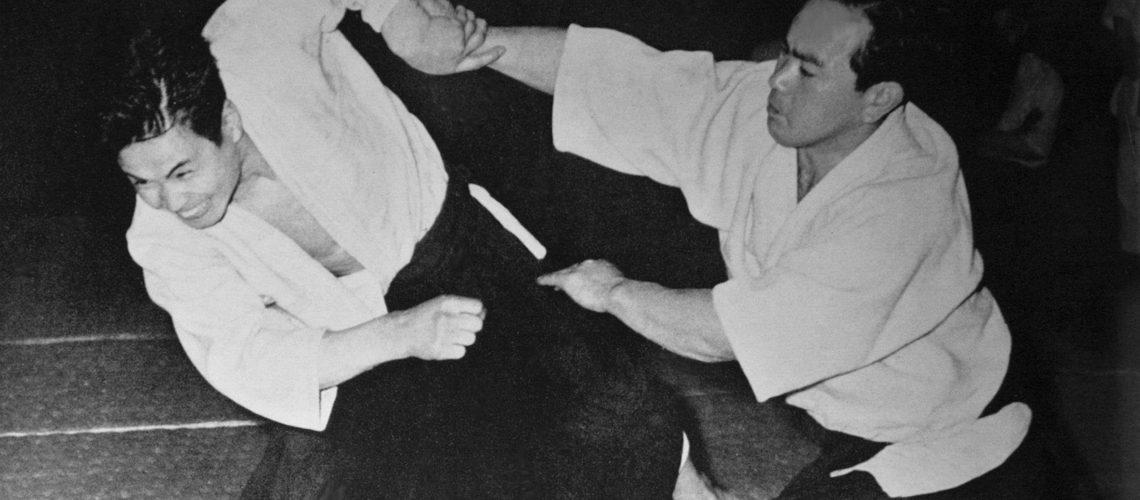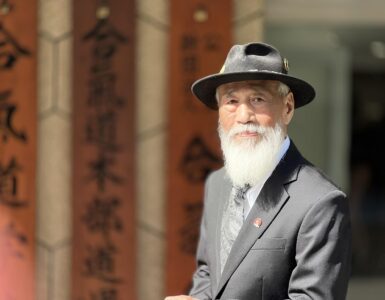by David Lynch
Aikido Journal #120

Arguments about the “martial effectiveness” of aikido are a popular feature of Internet bulletin boards. Unfortunately, many posts show an abysmal ignorance of the premises on which the art was founded by making comparisons with various systems of fighting.
Aikido is not a system of fighting, but a way of not fighting, intended not to protect or enhance the ego but, potentially, to eradicate it. Its value lies in promoting qualities diametrically opposed to those advocated for use “in the street.”
Speaking for myself, the day I have to face a life and death situation will be soon enough to prove the effectiveness, or otherwise, of my aikido. I have never had to use the physical techniques outside the dojo in 40 years of training, so I am not going to lose any sleep over that.
Certainly one should strive for improvement, and it is always a challenge to try and perform the techniques with a bit more smoothness and elan, but what is the point of raving on about the inadequacies of aikido, versus kickboxing, college wrestling and street fighting? There is quite enough material to work with in aikido as it stands, without resorting to cross-training, or worrying about which schools have lost the plot and left us with some watered down, ineffectual version. There is only so much you can learn from others, anyway, so you can’t blame the system for your own shortcomings.
Effectiveness is bought at a price and the more I see of those who claim to have achieved it in aikido, or in other areas of life, the more empathy I feel with ordinary people who have no great ambition to be super efficient or effective. At best this attitude is irrelevant, at worst downright destructive and depressing.
To be appreciated, aikido needs “space,” i.e., spirituality, psychological depth, aesthetics, compassion and enjoyment. Not to mention love! (There seems to be a tacit agreement not to mention love in the martial effectiveness arguments, which is curious in view of the importance O-Sensei placed on this, and his insistence that love was the essence of aikido.)
Not that aikido’s “spiritual effectiveness” is any easier to prove objectively than any of the technical arguments are. There are no guarantees, anyway. I am not convinced, however, that someone’s inability to perform a technique from, say, a strong Iwama-style morotedori grip testifies to a lack of spiritual development. The link between spirit, mind and body is more complicated than that.
The learning curve is a broad one, and one may reasonably expect to spend a lifetime working on oneself without being able to boast of full enlightenment, aikido or no aikido. This is no reason to abandon the effort, and practicing aikido with a spiritual goal in mind, rather than technical effectiveness alone, is a good start.
Meanwhile, the health benefits, mental as well as physical, amply justify serious, regular training, without the need to be fixated on martial effectiveness or intimidated by those who are. Since aikido is an individual pursuit, the school you choose is important only to the extent that it suits you and it is pointless attempting to pit one against another.
For myself, exposure to the contrasting teaching methods of Kisshomaru Ueshiba, Koichi Tohei, Gozo Shioda, Kenji Shimizu and others during my prolonged sojourn in Japan virtually forced me to seek whatever common principles I could find. I have tried to keep the door open to new knowledge, without falling into parochialism or sectarianism.
Aikido is not a system of fighting, but a way of not fighting, intended not to protect or enhance the ego but, potentially, to eradicate it. Its value lies in promoting qualities diametrically opposed to those advocated for use “in the street.”
But knowledge is not wisdom. Knowledge is derived by means of the senses, which cannot and were never intended to tell us anything about the truth of the universe. Chasing after more and more technical knowledge is likely to take one further from the goal of aikido, rather than closer to it.
I used to get a bit annoyed when I overheard people say that one or other of the various styles I was practicing was “not aikido.” (This seemed to be a common term of derision bandied around in Japan.) While I was willing to admit my own interpretation might leave much to be desired, it seemed incredibly arrogant for anyone to write off major Japanese aikido schools with this sort of flippant remark.
The major schools were established, after all, by masters who had each served a long apprenticeship under the founder, and who had devoted their lives to aikido. It became obvious to me after a while that the comment, “that is not aikido” was shallow and meaningless, and by the time I had heard it applied to every one of the major schools, it no longer bothered me.
Nevertheless, such a statement can easily discourage new students struggling to understand a particular version of the art, so I suggest they turn to O-Sensei’s words for advice on this:
“Failure is the key to success; each mistake teaches us something. Be grateful even for hardships, setbacks and bad people. Dealing with such obstacles is an essential part of training.” (From, “The Art of Peace,” by John Stevens.)
In relation to O-Sensei’s own definition of aikido, it is probably true that what we are practicing is “not aikido,” irrespective of what system of training we follow. In this respect we are all in the same boat; we all have a long way to go, as is obvious from O-Sensei’s words (quoting again from John Stevens’ book):
“There are many paths to the top of the mountain, but only one summit—love.”
“As soon as you concern yourself with the good and bad of your fellows you create an opening in your heart for maliciousness to enter. Testing, competing with, and criticizing others will weaken and defeat you.”
“You are here for no other purpose than to realize your own inner divinity and manifest your innate enlightenment.”
Senior aikidoka continue to criticize their fellows in other schools and to claim theirs is the only way to the top of the mountain, despite clearly not having reached the summit themselves.
I have found the different systems of training (which is all the schools are, since each individual must create his or her own aikido) complementary to a large extent, and I treat each as a piece of the greater puzzle.
For instance, Yoshinkan basics (kihon waza and kihon dosa) make a good foundation for the more movement-oriented training found in the Aikikai. In the Yoshinkan we used to do one technique for one hour and a vast number of solo tai no henko movements; there was no mention of relaxation, and ki was seen in terms of putting everything you had into what you were doing, without verbalizing this as a concept.
Uke was supposed to take “clean ukemi” and nage to perform “clean waza” and it was understood there was no competition, so that nothing would be gained by blocking or otherwise testing your partner. When individuals failed to heed this advice, things could quickly degenerate into an ugly trial of strength, as they could in any dojo when the principles of aikido were ignored.
I enjoyed training in the Aikikai Hombu for the speed, variety and relatively light training done there. Each of the senseis had a somewhat different approach, but overall there was more movement than in the Yoshinkan. When I first went there after my full-time stint in the Yoshinkan Hombu, people were running rings around me, literally! But after a while I got used to it and joined in the dance.
It is just unfortunate when ranking and other “political” considerations force students to make a choice between the different approaches, rather than accept without prejudice what each has to offer. People should consider themselves lucky if they find the kind of training that suits their temperament.
If it is true that Kisshomaru Ueshiba reduced the number of techniques that his father taught, then I am grateful to him, as there seem to be more than enough left. Kisshomaru Doshu could display a vast repertoire of different techniques in a single class. How many do you want?
While I can understand why some would consider the generally softer attacks and “token atemi” sometimes encountered in the Aikikai less realistic than elsewhere, I am not sure that argument would stand up to analysis. Who is to say that a powerful punch that would smash your teeth in if it connected is any more effective (in the context of dojo training) than a wave of the hand or a touch intended to alert uke to where the opening for an atemi existed?
One could certainly take issue, too, with the idea that a full-on “committed” attack was any more realistic than a softer version, given the fact that no competent attacker in the real world would advertise his intention and follow through with a single attack in such an obvious manner. He would be as devious as possible. Not that I am against training with “attitude,” it is just that powerful strikes seem ultimately no more realistic as preparation for reality than a wave of the hand—well, not a lot more anyway. (I make this point not to start an argument, but to illustrate the futility of arguing about such strictly relative matters.)
Kenji Shimizu of the Tendokan was fond of saying we should, “find the techniques within the movement” and that seems a sound approach too. The time spent concentrating on punching or gripping could be better spent learning how to move, if movement is your aim. But there is room for both approaches, surely.
Koichi Tohei’s “ki development exercises” I find excellent for warm-ups and improving balance and awareness. The almost complete lack of injuries in the Ki Society is itself a positive testimony to their method of training, unless of course you have so perverted aikido’s meaning as to count injuries as evidence of effectiveness. I don’t buy the criticism that Tohei’s teaching is superficial, as he was always telling us not to accept his principles intellectually but to work them out ourselves through training.
Those who ridicule ki training often have little or no experience of Tohei’s system, though I daresay his outspoken criticism of other schools (in which he is not alone) has invited much of the flack that is directed his way.
I recall an amusing incident at a dojo party when someone asked Tohei if he could move a teacup with his ki. “Certainly I can,” he replied and reached across to move the cup with his hand, adding that, “the mind and body are one.” To my recollection, he never claimed to be able to throw anyone with disembodied ki alone.
Of course, each system of training could claim to be complete in itself, and I am not necessarily advocating a blend of all of them. It is just that my own circumstances have enabled me to do this to some extent and I find that it works for me and seems to work for my students as well. No great disaster seems to have resulted in viewing each different system as part of a greater whole.
We need to try and see through the different personalities of the top senseis to appreciate where they are coming from. Perhaps one area in which we fall down in the West is in the amount of time we expect this process to take. The Japanese seem more comfortable with the idea that you would expect to spend a number of years if not decades in any one school before you could understand it properly.
It is just unfortunate when ranking and other “political” considerations force students to make a choice between the different approaches, rather than accept without prejudice what each has to offer. People should consider themselves lucky if they find the kind of training that suits their temperament.
A theoretical chart of “martial temperament” (Lynch’s ‘MT Chart,’ pat. pending), with “Mother Teresa” to the East and “Mike Tyson” to the West, might be useful to show the extremely different personalities and temperaments out there, and to help one decide where he or she fits on the line. But such a chart would be quite misleading if applied without reference to the philosophy of O-Sensei. It would be as one-dimensional and boring as most of the effectiveness theories. There would have to be an additional North-South line representing the human potential of the individual—a spiritual warp for the physical and emotional weft.
There is a Way to be followed if we are to approach the goal of aikido, which is no different to the goal of any of the teachings seriously concerned with man’s mental and spiritual evolution. The goal is a unitive knowledge of the divine principle, a direct intuition of spiritual reality and an awareness of the relationship of man and the universe. It is to find out who we are.
Of course the more there is of individual ego, the less there will be of this deeper understanding. Which explains why, wanting to be strong and to protect our egos, we make little progress in love or compassion. Instead of recognizing our ignorance of what really counts and making some effort, however small, to correct this, we spend our time arguing over technicalities, bogged down in materialism.
We look outside for more effective ways of fighting or defending ourselves, instead of inside for a more appropriate hypothesis, in keeping with the original rationale of the “Way of Harmony.”
In the end, we tend to get what we ask for.













Add comment